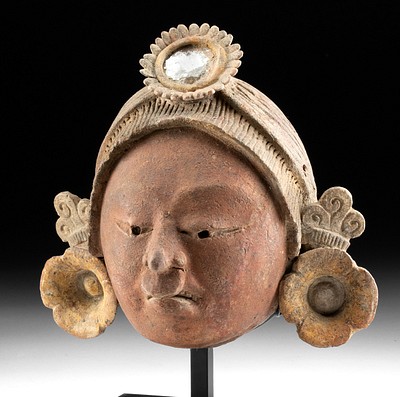Chinese Song Dynasty Stone Head of Buddha
Lot 75
About Seller
Artemis Gallery
686 S Taylor Ave, Ste 106
Louisville, CO 80027
United States
Selling antiquities, ancient and ethnographic art online since 1993, Artemis Gallery specializes in Classical Antiquities (Egyptian, Greek, Roman, Near Eastern), Asian, Pre-Columbian, African / Tribal / Oceanographic art. Our extensive inventory includes pottery, stone, metal, wood, glass and textil...Read more
Categories
Estimate:
$4,000 - $6,000
Absentee vs Live bid
Two ways to bid:
- Leave a max absentee bid and the platform will bid on your behalf up to your maximum bid during the live auction.
- Bid live during the auction and your bids will be submitted real-time to the auctioneer.
Bid Increments
| Price | Bid Increment |
|---|---|
| $0 | $25 |
| $300 | $50 |
| $1,000 | $100 |
| $2,000 | $250 |
| $5,000 | $500 |
| $10,000 | $1,000 |
| $20,000 | $2,500 |
| $50,000 | $5,000 |
| $100,000 | $10,000 |
| $200,000 | $20,000 |
About Auction
By Artemis Gallery
Jul 14, 2022
Set Reminder
2022-07-14 10:00:00
2022-07-14 10:00:00
America/New_York
Bidsquare
Bidsquare : Exceptional Antiquities Ethnographica Fine Art
https://www.bidsquare.com/auctions/artemis-gallery/exceptional-antiquities-ethnographica-fine-art-9692
Museum-worthy examples of classical antiquities (Egyptian, Greek, Roman, Near Eastern), Viking, Far East / Asian, Pre-Columbian, African / Tribal, Oceanic, Native American, Spanish Colonial, Fossils, Ancient Jewelry, Fine / Visual Arts, so much more! Artemis Gallery info@artemisgallery.com
Museum-worthy examples of classical antiquities (Egyptian, Greek, Roman, Near Eastern), Viking, Far East / Asian, Pre-Columbian, African / Tribal, Oceanic, Native American, Spanish Colonial, Fossils, Ancient Jewelry, Fine / Visual Arts, so much more! Artemis Gallery info@artemisgallery.com
- Lot Description
East Asia, China, Song Dynasty, ca. 960 to 1270 CE. A sensitively hand-carved stone Buddha head, a piece from a larger sculpture that perhaps resided in a shrine or temple. The visage is serene, the eyes cast downwards nearly closed, and the fleshy lips with slightly upturned edges. The coiffure is arranged in dozens of nodules, each craved with four lines to add swirling texture and indicate the upwards path towards the sun. His long ears droop downwards, having previously been stretched by heavy earrings and indicating his divinity and enlightenment. Size: 10" W x 16.7" H (25.4 cm x 42.4 cm); 22.8" H (57.9 cm) on included custom stand.
Social life during the Song period was vibrant. Citizens gathered to view and trade precious artwork, the populace intermingled at public festivals and private clubs, and cities had lively entertainment quarters. The spread of literature and knowledge was enhanced by the rapid expansion of woodblock printing and the 11th-century invention of movable-type printing. Technology, science, philosophy, mathematics, and engineering flourished over the course of the Song. Philosophers such as Cheng Yi and Zhu Xi reinvigorated Confucianism with new commentary, infused with Buddhist ideals, and emphasized a new organization of classic texts that brought out the core doctrine of Neo-Confucianism. Although the institution of the civil service examinations had existed since the Sui dynasty, it became much more prominent in the Song period. The officials who gained power by succeeding in the exams became a leading factor in the shift from a military-aristocratic elite to a bureaucratic elite. During the Song Dynasty, China expanded its trade along the Silk Road and South and Central Asian Buddhist proselytizers brought many sculptures and paintings of the Buddha into the country.
Provenance: private Hawaii, USA collection, 1995 to 2010; ex-M. Kobiashi collection, Hawaii, USA, acquired from 1960 to 2000
All items legal to buy/sell under U.S. Statute covering cultural patrimony Code 2600, CHAPTER 14, and are guaranteed to be as described or your money back.
A Certificate of Authenticity will accompany all winning bids.
PLEASE NOTE: Due to recent increases of shipments being seized by Australian & German customs (even for items with pre-UNESCO provenance), we will no longer ship most antiquities and ancient Chinese art to Australia & Germany. For categories of items that are acceptable to ship to Australia or Germany, please contact us directly or work with your local customs brokerage firm.
Display stands not described as included/custom in the item description are for photography purposes only and will not be included with the item upon shipping.
#172828Fragment of a larger piece. Restoration to right eye and brow. Minor losses to ears and light surface wear with areas of resurfacing, commensurate with age. Otherwise, excellent with impressive remaining detail. Removable from modern stand.Condition
- Shipping Info
-
All shipping is handled in-house for your convenience. Your invoice from Artemis Gallery will include shipping calculation instructions. If in doubt, please inquire BEFORE bidding for estimated shipping costs for individual items.
-
- Buyer's Premium



 EUR
EUR CAD
CAD AUD
AUD GBP
GBP MXN
MXN HKD
HKD CNY
CNY MYR
MYR SEK
SEK SGD
SGD CHF
CHF THB
THB














